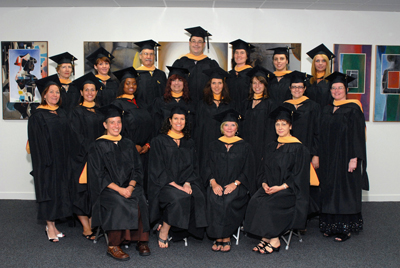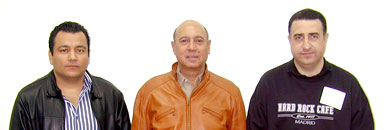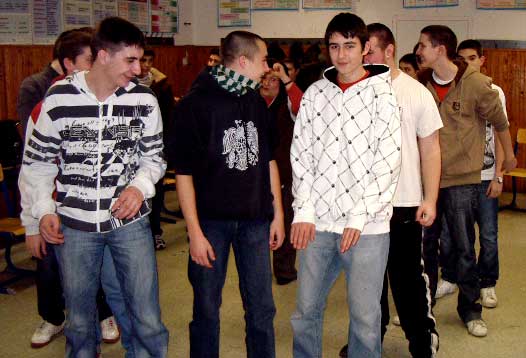News & Announcements
- Details
- Written by Laura Mirsky
From New York City, USA, a high school social worker researching restorative practices as a way to build school community and improve student behavior
From San Francisco, California, USA, the director of a new prison dorm for war veterans hoping to learn restorative solutions for inmates
From São Paolo, Brazil, a community trainer working in the most violent urban neighborhoods refining her knowledge of restorative techniques
From Canberra, ACT, Australia, an education graduate student seeking ways to engage pupils
From Twin Falls, Idaho, USA, a juvenile corrections district liaison hoping to learn how to spread restorative practices statewide
From Louisville, Kentucky, USA, a teachers’ union representative checking out restorative practices on behalf of his school district
- Details
- Written by Lorenn Walker, Rebecca Greening
The Huikahi Restorative Circle is a group reentry planning process involving the incarcerated individual, his or her family and friends and at least one prison representative. This article in the June 2010 issue of Federal Probation provides a history and philosophy of this restorative practice, as well as outcome data regarding those who have participated in the process, which show extremely high participant satisfaction rates as well as significantly less recidivism than current state of Hawai''i and national rates.
- Details
- Written by Laura Mirsky
 IIRP Class of 2010With friends and family looking on, 19 women and men received their degrees in restorative practices from the IIRP Graduate School, at the joyous commencement ceremony on June 19, 2010, in Bethlehem, Pennsylvania, USA. Jill K. Dreibelbis, Eileen V. Hovey, Marlene Karen Ruby and Kate Burns Spokas Shapero received the Master of Restorative Practices and Education, and Roxanne Atterholt, Stacey Ann Bean, Christi L.Blank, Mardochee T. Casimir, Julia Maye Malloy, Sharon L. Mast, Ann Phoebe Moyer, Lynette Vineis Reed, Tami Beth Ritter, Mary Schott, Michele Wertz Snyder, John Douglas Tocado, Kelly L. Trzaska, Paul Jeffrey Werrell and Melinda Lappin Zipin received the Master of Restorative Practices and Youth Counseling.
IIRP Class of 2010With friends and family looking on, 19 women and men received their degrees in restorative practices from the IIRP Graduate School, at the joyous commencement ceremony on June 19, 2010, in Bethlehem, Pennsylvania, USA. Jill K. Dreibelbis, Eileen V. Hovey, Marlene Karen Ruby and Kate Burns Spokas Shapero received the Master of Restorative Practices and Education, and Roxanne Atterholt, Stacey Ann Bean, Christi L.Blank, Mardochee T. Casimir, Julia Maye Malloy, Sharon L. Mast, Ann Phoebe Moyer, Lynette Vineis Reed, Tami Beth Ritter, Mary Schott, Michele Wertz Snyder, John Douglas Tocado, Kelly L. Trzaska, Paul Jeffrey Werrell and Melinda Lappin Zipin received the Master of Restorative Practices and Youth Counseling.
- Details
- Written by Laura Mirsky
Both Mexico and New Orleans, Louisiana, USA, are experiencing high incidences of crime and violence. To find new ways to deal with this issue, participants from both locations recently attended special four-day immersion events at the IIRP’s Bethlehem campus. An April 26-29 event involved 30 criminal and juvenile justice officials from 10 states in Mexico; a May 11-14 immersion included 15 educators and youth-justice professionals from New Orleans.
 Tabasco State Attorney General’s Office: Manasés Sylvan Olan, Deputy Attorney General For Legal Processes; Rafael Miguel González Lastra, Attorney General; Mario Alberto Dueñas Zentella, Director of Training
Tabasco State Attorney General’s Office: Manasés Sylvan Olan, Deputy Attorney General For Legal Processes; Rafael Miguel González Lastra, Attorney General; Mario Alberto Dueñas Zentella, Director of Training
Both groups spent two days visiting the IIRP’s model program schools for at-risk youth, operated by Community Service Foundation and Buxmont Academy (CSF Buxmont), and two days training in restorative practices. The participants were very excited about what they observed and learned, and most are hoping to begin implementing restorative practices when they return home.
The seeds for the Mexicans’ visit were planted when John Bailie, IIRP director of trainers and lecturer at the IIRP Graduate School, presented a paper at the First International Restorative Justice Conference: Humanizing the Approach to Criminal Justice, in Oaxaca, Mexico, in September 2008. Subsequently, Nancy Flemming, coordinator of the alternative justice area of MSI’s (Management Systems International) Programa de Apoyo para el Estado de Derecho en México [Support Program for the Rule of Law in Mexico — PRODERECHO project, funded by USAID], organized the IIRP visit to help immersion attendees find ways to improve their respective states’ criminal justice systems. This undertaking was mandated by a 2006 amendment to the Mexican constitution requiring states to reform their penal codes to make them more effective and more humane — to include oral trials, the right to legal counsel and other legal prerogatives. Many of the immersion participants are involved in this reform process, in a variety of ways.
- Details
- Written by Laura Mirsky
 Judy Happ, vice president for administration at the IIRP Graduate School and president of Community Service Foundation and Buxmont Academy, delivered the alumni commencement address at Shippensburg University’s School of Graduate Studies, in Shippensburg, Pennsylvania, USA, on May 7, 2010. The following are excerpts from the address.
Judy Happ, vice president for administration at the IIRP Graduate School and president of Community Service Foundation and Buxmont Academy, delivered the alumni commencement address at Shippensburg University’s School of Graduate Studies, in Shippensburg, Pennsylvania, USA, on May 7, 2010. The following are excerpts from the address.
I am vice president for administration for the International Institute for Restorative Practices Graduate School. We teach educators and others who work with children and youth to employ restorative practices in their work.
Restorative practices are processes and strategies for the development, repair or improvement of relationships, social capital and social discipline through collaborative empowerment.
- Details
- Written by American Humane Association and the FGDM Guidelines Committee
American Humane’s National Center on Family Group Decision Making, in coordination with the FGDM Guidelines Committee, has published Guidelines for Family Group Decision Making in Child Welfare, a comprehensive 63-page handbook covering all aspects of the FGDM process and philosophy, from basic explanations, history and values to detailed descriptions of the role of the coordinator, the referral process, preparation, the family meeting, follow-up and administrative support.
- Details
- Written by Laura Mirsky
 Hungarian high school students participate in a restorative exercise, forming a “boat” and “rowing” into the future, with their teacher at the center.In April 2010 Vidia Negrea, director of Community Service Foundation (CSF) Hungary, provided an introductory training in facilitating restorative conferences for four different youth group homes in Budapest. This is just the latest development in her work spreading restorative practices in Hungary, which also includes major efforts in schools and prisons.
Hungarian high school students participate in a restorative exercise, forming a “boat” and “rowing” into the future, with their teacher at the center.In April 2010 Vidia Negrea, director of Community Service Foundation (CSF) Hungary, provided an introductory training in facilitating restorative conferences for four different youth group homes in Budapest. This is just the latest development in her work spreading restorative practices in Hungary, which also includes major efforts in schools and prisons.
Psychologist Negrea came to Bethlehem, Pennsylvania, USA, in 2000 to learn about restorative practices and has never looked back. (See: www.iirp.edu/article_detail.php?article_id=NDUw, www.iirp.edu/article_detail.php?article_id=NDM0 and www.iirp.edu/article_detail.php?article_id=NTk1 for three articles which give a history of Negrea’s work bringing restorative practices to Hungary.)
Her recent work has been supported by the Ministry of Justice Hungary and the city of Budapest, including a project to reduce aggressive behavior in children and youth, which is bringing restorative practices to six big-city high schools.
- Details
- Written by IIRP
Script for facilitators of restorative conferences. Download PDF version.
- Details
- Written by Laura Mirsky
The Sanctuary Model is a non-hierarchical, highly participatory, “trauma-informed and evidence-supported” operating system for human services organizations, which helps them function in a humane, democratic and socially responsible manner and thereby provide effective treatment for clients in a clinical setting. The model is entirely congruent with restorative practices, in that it is about working with people instead of doing things to them or for them.
Not a specific treatment intervention, the Sanctuary Model provides a structure and common language for people in human services fields to communicate and collaborate with each other. Said Dr. Sandra Bloom, developer of the model: “Social workers, psychiatrists and nurses don’t share a common way of working with clients. The Sanctuary Model gets everybody on the same trauma-informed page.”
Bloom is founder and “guiding light” of the Sanctuary Institute at Andrus Children’s Center, in Yonkers, New York, USA (http://andruschildren.org/?page_id=836), associate professor of Health Management and Policy at the School of Public Health and codirector of the Center for Nonviolence and Social Justice (www.nonviolenceandsocialjustice.org), at Drexel University, Philadelphia, Pennsylvania, USA. She summed up the Sanctuary Model:
Most clients who present to human service delivery organizations have been exposed to significant adversity, chronic stress, and frequently overwhelming trauma. … [But] they cannot heal within the context of traumatizing — or traumatized — organizations that may actually create more, not less pathology. The goal of the Sanctuary Model is to facilitate the development of an organizational culture that can contain, manage, and help transform the terrible life experiences that have molded — and often deformed — the clients in care. But no one person can change an organizational culture — at least not for the better. Living systems are comprised of living people who tend to support what they help to create — and who fail to support change efforts that exclude them.
- Details
- Written by Lynn M. Welden
The Gordon family (names are fictitious), of Bucks County, Pennsylvania, USA, recently experienced a life-affirming restorative process — a family group decision-making (FGDM) conference (also called family group conferencing or FGC). The family (four young adult children — two boys and two girls — their divorced parents, Linda and Bob, as well as several members of their extended family) came together in an FGDM conference to help 17-year-old son Sam take better control of his life. The process worked extremely well for Sam, but what the family didn’t expect, they said, was that the FGDM would also enhance their connections and relationships in many other ways.
During the past year, Sam started using drugs and alcohol, hanging out with fellow “users” in school and buying and selling marijuana. He had trouble sharing his feelings, had problems with self-esteem and, according to his father, started making rash decisions and looking for instant gratification. “My son is a good, bright kid,” said Sam’s father. “He is very talented. The stuff he got involved with was really stupid.” Sam’s actions ultimately led to his involvement in a car accident and arrest on DWI (driving while intoxicated) charges related to marijuana use.

Restorative Works Year in Review 2023 (PDF)
All our donors are acknowledged annually in Restorative Works.
